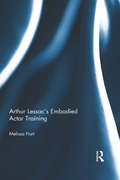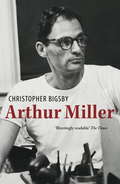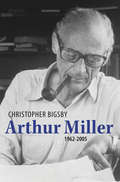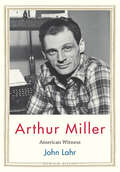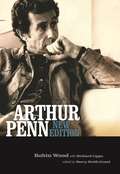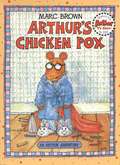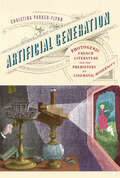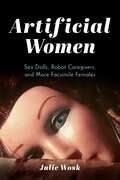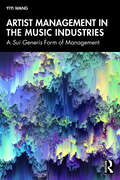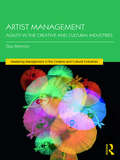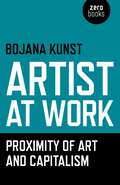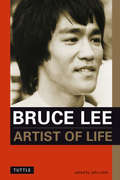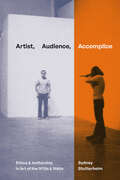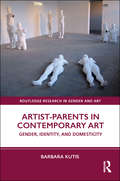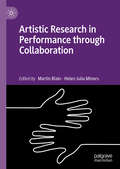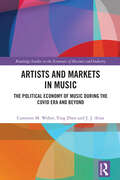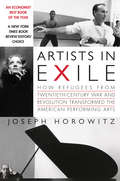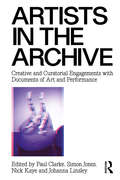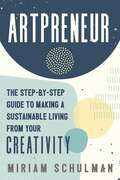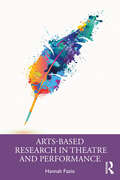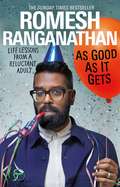- Table View
- List View
Arthur Lessac's Embodied Actor Training
by Melissa HurtArthur Lessac’s Embodied Actor Training situates the work of renowned voice and movement trainer Arthur Lessac in the context of contemporary actor training. Supported by the work of Constantin Stanislavsky and Maurice Merleau-Ponty's theories of embodiment, the book explores Lessac's practice in terms of embodied acting, a key subject in contemporary performance. In doing so, the author explains how the actor can come to experience both skill and expression as a subjective whole through active meditation and spatial attunement. As well as feeding this psychophysical approach into a wider discussion of embodiment, the book provides concrete examples of how the practice can be put into effect. Using insights gleaned from interviews conducted with Lessac and his Master Teachers, the author enlightens our own understanding of Lessac’s practices. Three valuable appendices enhance the reader’s experience. These include: a biographical timeline of Lessac’s life and career sample curricula and a lesson plan for teachers at university level explorations for personal discovery Melissa Hurt is a Lessac Certified Trainer and has taught acting and Lessac’s voice, speech, and movement work at colleges across the United States. She has a PhD from the University of Oregon and an MFA from Virginia Commonwealth University.
Arthur Miller: 1962-2005
by Christopher BigsbyBiography of one of the greatest of modern playwrights, Arthur Miller (1915-2005).This is the long-awaited biography of one of the twentieth century's greatest playwrights whose postwar decade of work earned him international critical and popular acclaim.Arthur Miller was a prominent figure in American literature and cinema for over sixty years, writing a wide variety of plays - including The Crucible, A View from the Bridge, All My Sons, and Death of a Salesman - which are still performed, studied and lauded throughout the world.Born in 1915 to moderately affluent Jewish-American parents, Miller wrote during a fascinating time in American history. The Great Depression was a period of deprivation for many that left an indelible mark on the national psyche, and, like many, Miller found hope for the beleaguered common man in Communism. The Second World War elevated the common man to war hero, but when the Cold War subsequently began, the ugly elements of American conservatism freely persecuted writers and artists who had embraced Communism. Miller was among them. His refusal to give evidence against others to the notorious House Un-American Activities Committee in 1956 gave him a heroic role to play. In that same year, Arthur Miller momentously married the young actress Marilyn Monroe, a marriage that remains famous to this day. Christopher Bigsby's gripping, meticulously researched biography, based on boxes of papers made available to him before Miller's death, offers new insights into their marriage, and sheds new light on how their relationship informed Miller's subsequent great plays. After his death in 2005, many respected actors, directors and producers paid tribute to Miller, calling him 'the last great practitioner of the American stage'. Christopher Bigsby's supremely authoritative biography does full justice to Miller's life and art.
Arthur Miller: 1962-2005
by Christopher BigsbyThe second volume of the definitive biography of one of the greatest modern playwrights, Arthur Miller (1915-2005).The first volume of Christopher Bigsby's award-winning biography of Arthur Miller was hailed as a masterpiece and the definitive account of Miller's early years. This is the second half of Miller's captivating story, covering his life from 1962 to his death in 2005.In 1962, Miller's legacy was incomplete. Ahead lay eighteen plays, five films, a novella and a handful of stories. On a personal level, 1962 saw the death of his second wife, the iconographic Marilyn Monroe, and his marriage to the photographer Inge Morath who was to transform him as a writer and a person. A visit to Mauthaussen concentration camp and to the Frankfurt trials of Auschwitz-Birkenau guards moved the Holocaust to the centre of his attention and he became a more directly political person. Christopher Bigsby brilliantly and elegantly maps out the journey of Miller's life and work. Shedding new light on Miller's complexities, and revealing unknown facts about his public and private life, Bigsby shares new insights and perspectives crucial to an understanding of one of the world's greatest playwrights.
Arthur Miller: 1962-2005
by Christopher BigsbyThe second volume of the definitive biography of one of the greatest modern playwrights, Arthur Miller (1915-2005).The first volume of Christopher Bigsby's award-winning biography of Arthur Miller was hailed as a masterpiece and the definitive account of Miller's early years. This is the second half of Miller's captivating story, covering his life from 1962 to his death in 2005.In 1962, Miller's legacy was incomplete. Ahead lay eighteen plays, five films, a novella and a handful of stories. On a personal level, 1962 saw the death of his second wife, the iconographic Marilyn Monroe, and his marriage to the photographer Inge Morath who was to transform him as a writer and a person. A visit to Mauthaussen concentration camp and to the Frankfurt trials of Auschwitz-Birkenau guards moved the Holocaust to the centre of his attention and he became a more directly political person. Christopher Bigsby brilliantly and elegantly maps out the journey of Miller's life and work. Shedding new light on Miller's complexities, and revealing unknown facts about his public and private life, Bigsby shares new insights and perspectives crucial to an understanding of one of the world's greatest playwrights.
Arthur Miller: American Witness (Jewish Lives)
by John LahrA great theater critic brings twentieth-century playwright Arthur Miller&’s dramatic story to life with bold and revealing new insights &“New Yorker critic Lahr shines in this searching account of the life of playwright Arthur Miller. . . . It&’s a great introduction to a giant of American letters.&”—Publishers Weekly Distinguished theater critic John Lahr brings unique perspective to the life of Arthur Miller (1915–2005), the playwright who almost single-handedly propelled twentieth-century American theater into a new level of cultural sophistication. Organized around the fault lines of Miller&’s life—his family, the Great Depression, the rise of fascism, Elia Kazan and the House Committee on Un-American Activities, Marilyn Monroe, Vietnam, and the rise and fall of Miller&’s role as a public intellectual—this book demonstrates the synergy between Arthur Miller&’s psychology and his plays. Concentrating largely on Miller&’s most prolific decades of the 1940s, 1950s, and 1960s, Lahr probes Miller&’s early playwriting failures; his work writing radio plays during World War II after being rejected for military service; his only novel, Focus; and his succession of award-winning and canonical plays that include All My Sons, Death of a Salesman, and The Crucible, providing an original interpretation of Miller&’s work and his personality.
Arthur Penn: New Edition
by Barry Keith Grant Robin Wood Richard LippeArthur Penn--director of The Miracle Worker, Bonnie and Clyde, Alice's Restaurant, and Little Big Man--was at the height of his career when Robin Wood's analysis of the American director was originally published in 1969. Although Wood then considered Penn's career only through Little Big Man, Arthur Penn remains the most insightful discussion of the director yet published. In this new edition, editor Barry Keith Grant presents the full text of the original monograph along with additional material, showcasing Wood's groundbreaking and engaging analysis of the director. Of all the directors that Wood profiled, Penn is the only one with whom he developed a personal relationship. In fact, Penn welcomed Wood on the set of Little Big Man (1969), where he interviewed the director during production of the film and again years later when Penn visited Wood at home. Both interviews are included in this expanded edition of Arthur Penn, as are five other pieces written over a period of sixteen years, including the extended discussion of The Chase that was the second chapter of Wood's later important book Hollywood from Vietnam to Reagan. The volume also includes a complete filmography and a foreword by Barry Keith Grant. The fourth classic monograph by Wood to be republished by Wayne State University Press, this volume will be welcomed by film scholars and readers interested in American cinematic and cultural history.
Arthur's Chicken Pox
by Marc BrownThis adventure revolves around whether or not Arthur will get over his chicken pox in time to go to the circus with his family. In the meantime, D.W. makes her own plans to invite a friend to go as Arthur's replacement and feigns chicken pox herself in a bid for attention from her family. At the end of the story, in a nod to justice, Arthur recovers in time, but D.W. comes down with spots on the morning of the circus.
Artifacts of a '90s Kid: Humorous Musings and Observations for Every Millennial
by Alana HitchellShe reminds you what it was like to grow up during an era that consisted of playing countless hours of Nintendo, reading Lurlene McDaniel books, and wearing Esprit T-shirts and Yoyo jeans. With no real responsibilities to worry about, a typical day involved playing board games, eating junk food, and obsessing over the latest Lisa Frank stickers.Artifacts of a ’90s Kid is a candid, coming-of-age, humorous account of Alana’s experiences as a millennial growing up in Central Illinois. It focuses on her elementary and junior high school years (1992–1999) and includes present-day commentary. Alana offers up a hilarious compilation of diary entries, homework fails, notes, artwork, poetry, and awkward photos from her childhood—all that and a bag of chips!Although the handwriting and spelling can be atrocious at times, millennials will relate to Alana’s diary entries describing a very innocent, honest, and naive time when life was simple and carefree. Featuring many milestones of growing up—from making friends, to crushes, to being overly dramatic—along with some totally dope nineties references that every millennial is sure to enjoy.
Artificial Generation: Photogenic French Literature and the Prehistory of Cinematic Modernity
by Christina Parker-FlynnArtificial Generation: Photogenic French Literature and the Prehistory of Cinematic Modernity investigates the intersection of film theory and nineteenth-century literature, arguing that the depth of amalgamation that occurred within literary representation during this era aims to replicate an illusion of life and its sensations, in ways directly related to broader transitions into our modern cinematic age. A key part of this evolution in representation relies on the continual re-emergence of the artificial woman as longstanding expression of masculine artistic subjectivity, which, by the later nineteenth century, becomes a photographic and filmic drive. Moving through the beginning of film history, from Georges Méliès and other “silent” filmmakers in the 1890s, into more contemporary movies, including Alfred Hitchcock’s Vertigo (1958) and Blade Runner 2049 (2017), the book analyzes how films are often structured around the prior century’s mythic and literary principles, which now serve as foundation for film as medium—a phantom form for life’s re-presentation. Artificial Generation provides a crucial reassessment of the longstanding, mutual exchange between cinematic and literary reproduction, offering an innovative perspective on the proto-cinematic imperative of simulation within nineteenth-century literary symbolism.
Artificial Women: Sex Dolls, Robot Caregivers, and More Facsimile Females
by Julie WoskWhat distinguishes humanity from artificial beings? What do constructed creatures tell us about ourselves? From sex dolls to Siri, talking Barbies to robotic mothers, Artificial Women explores the ways in which today's simulated females—both real and fictional—reflect and expose our own ideas about gender and female identity. Join Julie Wosk as she probes the realm of compliant sex workers, nurturing caretakers, genial servants, and rebellious creations in film, television, literature, art, photography, and current developments in robotics. These modern-day Galateas must embrace their own synthetic nature while also striving for authenticity and autonomy, all the while foregrounding gender stereotypes and changing perceptions of women and their roles. They embody the paradoxes and tensions that continue to arise in our increasingly simulated world, where the lines between the real and the virtual only continue to blur. As these "artificial women" become ever more lifelike, so too do the questions they raise become more provocative, and more illuminating of our own conceptions and conventions. Artificial Women pushes the boundaries of gender, sexuality, and culture studies to consider new digital technologies, artificial intelligences, and burgeoning simulations.
Artist Management in the Music Industries: A Sui Generis Form of Management
by Yiyi WangArtist Management in the Music Industries: A Sui Generis Form of Management provides one of the first substantive, academic examinations of the role of an artist manager.This book deconstructs the nature of Artist Management, unveiling the pivotal role of the artist manager in creating and sustaining a dynamic environment referred to as the ‘Loop’, where success is realised by navigating four variables – Risks, Relationships, Emotions, and Expectations (2Rs and 2Es) – within and beyond the ‘Loop’. This book offers a new perspective on Artist Management as a sui generis discipline that does not fit easily inside standard conceptions of management.Featuring ethnography and interviews, this book sheds light on the realworld challenges and successes in the field. It is a must-read for researchers, students, and practitioners in the music business, music marketing, and artist management, offering invaluable insights into the practices that shape the cultural landscape.
Artist Management: Agility in the Creative and Cultural Industries (Mastering Management in the Creative and Cultural Industries)
by Guy MorrowArtists are creative workers who drive growth in the creative and cultural industries. Managing artistic talent is a unique challenge, and this concise book introduces and analyses its key characteristics. Artist Management: Agility in the Creative and Cultural Industries makes a major contribution to our understanding of the creative and cultural industries, of artistic and managerial creativities, and of social and cultural change in this sector. The book undertakes an extensive exploration of the increasingly pivotal role of artist managers in the creative and cultural industries and argues that agile management strategies are useful in this context. This book provides a comprehensive and accessible account of the artist–artist manager relationship in the twenty-first century. Drawing from research interviews conducted with artist managers and self-managed artists in five cities (New York, London, Toronto, Sydney and Melbourne), this book makes an original contribution to knowledge. Nation-specific case studies are highlighted as a means of illuminating various thematic concerns. This unique book is a major piece of research and a valuable study aid for both undergraduate and postgraduate students of subjects including arts management, creative and cultural industries studies, arts entrepreneurship, business and management studies and media and communications.
Artist at Work, Proximity of Art and Capitalism
by Bojana KunstThe main affirmation of artistic practice must today happen through thinking about the conditions and the status of the artist's work. Only then can it be revealed that what is a part of the speculations of capital is not art itself, but mostly artistic life. Artist at Work examines the recent changes in the labour of an artist and addresses them from the perspective of performance.
Artist of Life
by Bruce LeeA rare, never-before-seen collection of Bruce Lee's private letters and writing! Bruce Lee was an intense man with such sheer concentration of energy that no one who encountered him, on screen or in person, could help but be drawn to him and his enthusiasm for life and knowledge. A voracious and engaged reader, Lee wrote extensively, synthesizing the thought of East and West into a unique personal philosophy of self-discovery. Bruce Lee: Artist of Life explores the development and fruition of Bruce Lee's thoughts about gung fu (kung fu), philosophy, psychology, poetry, jeet kune do, acting, and self-knowledge. This volume from Bruce Lee's private notebooks is capped by a selection of Lee's letters that eloquently demonstrate how he incorporated his thought into actions and advice to others. Also included are multiple drafts of select compositions, showing how Lee's thought evolved and was refined over the years and how the ideas he was reading and writing about were reflected in his work and everyday life. Sections include: Gung Fu—reflections on gung fu, psychology in defense and attack, how to choose a martial arts instructor, and Bruce's own view on the martial art Philosophy—regarding human understanding, Taoism, Plato, Socrates, and Descartes Psychology—three types of philosophy, the top dog and the underdog, the four basic philosophical approaches, and learning Poetry—'The Dying Sun,' 'Love is a Friendship Caught on Fire,' 'Once More I Hold You in My Arms,' and 'Parting' Jeet Kune Do–The Liberation—toward personal liberation, notes on JKD, true mastery, and an objective evaluation of the combative skill of Bruce Lee, by those who know what it is Acting—what exactly is an actor, the art of acting Self-knowledge—in search of someone real, self-actualization, and the passionate state of mind Letters—'The True Meaning of Life–Peace of Mind,' 'Use Your Own Experience and Imagination,' and 'It's All in the State of Mind'
Artist, Audience, Accomplice: Ethics and Authorship in Art of the 1970s and 1980s
by Sydney StutterheimIn Artist, Audience, Accomplice, Sydney Stutterheim introduces a new figure into the history of performance art and related practices of the 1970s and 1980s: the accomplice. Occupying roles including eyewitness, romantic partner, studio assistant, and documenter, this figure is situated between the conventional subject positions of the artist and the audience. The unseen and largely unacknowledged contributions of such accomplices exceed those performed by a typical audience because they share in the responsibility for producing artworks that entail potential ethical or legal transgressions. Stutterheim analyzes the art of Chris Burden, Hannah Wilke, Martin Kippenberger, and Lorraine O’Grady, showing how each cannily developed strategies of shared culpability that evoked questions about the accomplice’s various rights and roles. In this way, Stutterheim argues that the artist’s authority is not sovereign, total, or exclusive but, rather, fluid and relational. By examining the development of an alternative model of participatory art that relies on a network of accomplices, Stutterheim radically revises current understandings of artistic agency, aesthetic property, and acknowledged authorship.
Artist-Parents in Contemporary Art: Gender, Identity, and Domesticity (Routledge Research in Gender and Art)
by Barbara KutisThis book examines the increasing intersections of art and parenting from the late 1990s to the early 2010s, when constructions of masculine and feminine identities, as well as the structure of the family, underwent radical change. Barbara Kutis asserts that the championing of the simultaneous linkage of art and parenting by contemporary artists reflects a conscientious self-fashioning of a new kind of identity, one that she calls the ‘artist-parent.’ By examining the work of three artists—Guy Ben-Ner, Elżbieta Jabłońska, and the collective Mothers and Fathers— this book reveals how these artists have engaged with the domestic and personal in order to articulate larger issues of parenting in contemporary life. This book will be of interest to scholars in art and gender, gender studies, contemporary art, and art history.
Artistic Research in Performance through Collaboration
by Helen Julia Minors Martin BlainThis volume explores the issue of collaboration: an issue at the centre of Performance Arts Research. It is explored here through the different practices in music, dance, drama, fine art, installation art, digital media or other performance arts. Collaborative processes are seen to develop as it occurs between academic researchers in the creative arts and professional practitioners in commercial organisations in the creative arts industries (and beyond), as well as focusing attention and understanding on the tacit/implicit dimensions of working across different media.
Artists and Markets in Music: The Political Economy of Music During the Covid Era and Beyond (Routledge Studies in the Economics of Business and Industry)
by Cameron M. Weber Ying Zhen J.J. AriasThis monograph is an innovative examination of the political economy of music. It integrates original economic theories and empirical research to shed light on the economic and social forces shaping music and society today. Interactive relationships, such as the importance of entrepreneurship, serendipity and authenticity, will be explored in artist subjective determinations of success. In particular, this book deeply explores the mental health of musicians and "creative destruction" during the covid era, copyrights in music markets and an evaluation of the importance of entrepreneurship and brand marketing in the life of musical artists. The monograph contributes empirical research to underexplored areas in the cultural economics of music, such as the proposed musical production function by Samuel Cameron (Routledge 2015) and the concept of distinction in cultural production by Pierre Bourdieu (Routledge 1984, 2010) as uniquely applied with examples from the covid era. Readers will benefit from this easy-to-understand interdisciplinary exploration of the music industry with a focus on the United States and the political economy of music during the covid era. Most cultural economics is focused on Europe and Asia, so this emphasis on the United States will be of interest. This book will be a beneficial reference work for researchers and will find an audience among music professionals and artists. Academics and non-academics, experts and novices interested in music and political economy will also find value in Artists and Markets in Music.
Artists and the Arab Uprisings
by Lowell H. Schwartz Dalia Dassa Kaye Jeffrey MartiniRegional artists can play a positive role in shaping public debate and supporting democratic transition in the Middle East. This report explores the challenges artists have faced since the Arab uprisings, U. S. government programs to support arts in the region, and the wide array of nongovernmental activities to engage Arab artists, offering recommendations to improve support for these artists.
Artists in Exile
by Joseph HorowitzDuring the first half of the twentieth century--decades of war and revolution in Europe--an "intellectual migration" relocated thousands of artists and thinkers to the United States, including some of Europe's supreme performing artists, filmmakers, playwrights, and choreographers. For them, America proved to be both a strange and opportune destination. A "foreign homeland" (Thomas Mann), it would frustrate and confuse, yet afford a clarity of understanding unencumbered by native habit and bias. However inadvertently, the condition of cultural exile would promote acute inquiries into the American experience. What impact did these famous newcomers have on American culture, and how did America affect them? George Balanchine, in collaboration with Stravinsky, famously created an Americanized version of Russian classical ballet. Kurt Weill, schooled in Berlin jazz, composed a Broadway opera. Rouben Mamoulian's revolutionary Broadway productions of Porgy and Bess and Oklahoma! drew upon Russian "total theater." An army of German filmmakers--among them F. W. Murnau, Fritz Lang, Ernst Lubitsch, and Billy Wilder--made Hollywood more edgy and cosmopolitan. Greta Garbo and Marlene Dietrich redefined film sexuality. Erich Korngold upholstered the sound of the movies. Rudolf Serkin inspirationally inculcated dour Germanic canons of musical interpretation. An obscure British organist reinvented himself as "Leopold Stokowski." However, most of these gifted émigrés to the New World found that the freedoms they enjoyed in America diluted rather than amplified their high creative ambitions.A central theme of Joseph Horowitz's study is that Russians uprooted from St. Petersburg became "Americans"--they adapted. Representatives of Germanic culture, by comparison, preached a German cultural bible--they colonized. "The polar extremes," he writes, "were Balanchine, who shed Petipa to invent a New World template for ballet, and the conductor George Szell, who treated his American players as New World Calibans to be taught Mozart and Beethoven." A symbiotic relationship to African American culture is another ongoing motif emerging from Horowitz's survey: the immigrants "bonded with blacks from a shared experience of marginality"; they proved immune to "the growing pains of a young high culture separating from parents and former slaves alike."
Artists in the Archive: Creative and Curatorial Engagements with Documents of Art and Performance
by Simon Jones Paul Clarke Nick Kaye Johanna LinsleyArtists in the Archive explores the agency and materiality of the archival document through a stunning collection of critical writings and original artworks. It examines the politics and philosophy behind re-using remains, historicising this artistic practice and considering the breadth of ways in which archival materials inform, inflect and influence new works. Taking a fresh look at the relationships between insider know-how and outsider knowledge, Artists in the Archive opens a vital dialogue between a global range of artists and scholars. It seeks to trouble the distinction between artistic practice and scholarly research, offering disciplinary perspectives from experimental theatre, performance art, choreography and dance, to visual art making, archiving and curating.
Artpreneur: The Step-by-Step Guide to Making a Sustainable Living From Your Creativity
by Miriam SchulmanA step-by-step guide for creatives to transform your passion into a profitable business.Whether you&’re a musician, photographer, painter, writer, dancer, singer, or any other creative with aspirations of making a living from your art, this is the perfect time to turn your creative ideas into a sustainable business. With gatekeepers no longer controlling the market, anyone with a laptop and a dream can make a thriving living from their creativity.This is the definitive sales and marketing playbook for anyone looking to make a living from their art. Each page provides the inspiration and practical steps you need to build a personal brand, overcome starving-artist syndrome, and finally make consistent sales from your art. By combining left-brain traditional marketing methods with the tools you&‘ll build a confident mindset, take charge of your destiny, and create a clear path for success.Miriam Schulman, host of the Inspiration Place podcast, breaks down the five core elements in the &“Passion to Profit&” planning framework to help you develop your art business—so that you can have the time and freedom to do what you love:PROSPECTING: Build an audience of followers who want what you've got and are prepared to pay top dollar.PRODUCTION: Draw attention to your creations by embracing your authenticity.PRODUCTIVITY: Create work-life balance by managing your priorities and setting manageable goals.PROMOTION: Attract collectors in an authentic and non-salesy way.PRICING: Price your art, products, or services based on cutting edge research that explains buyer psychology.After twenty years of selling art as well as coaching other artists, Miriam knows that now is the time to leave the rat race and pursue your highest dreams. Don&’t wait for a sign from the universe to gamble on yourself.
Arts-Based Research in Theatre and Performance
by Hannah FazioArts-based Research in Theatre and Performance provides a roadmap for conducting arts-based research. It offers a vibrant exploration of how ethnography, autoethnography, poetry, and fiction can be used successfully in research projects.This volume delves into a rich array of works from the theatre and performance canon, reframing them through the lens of arts-based research. Readers are introduced to the innovative methodologies and bold contributions of diverse artists and scholars, both contemporary and historical, who may help redefine how readers understand, document, and engage with performance as arts-based research. Each chapter walks the reader through practical exercises so they can develop their techniques and research projects.With reflections on professional and academic practice throughout, this is an accessible guide for students and practitioners wanting to conduct their own arts-based research in theatre, performance, drama therapy, drama education, applied theatre, and other similar fields.
As Glenn as Can Be
by Sarah EllisA warm and witty portrait of child prodigy and world-famous classical musician Glenn Gould. Glenn was a child who knew his own mind — he liked boats but did not like fishing; he enjoyed puns and pranks but did not like bullying; he loved learning but did not like school … but more than anything else he loved to play the piano. Glenn had a professional performing career by the time he was fifteen; he gave concerts all over the world in his twenties. He became best known for his interpretation of Bach’s Goldberg Variations. But Glenn grew to dislike concerts — the hall was too cold, or he didn’t feel well, or the audience made too much noise (he didn’t even like their applause!). He discovered that when he played and recorded music in an empty concert hall, he could make it sound exactly the way he wanted. He could do what he loved best, while being completely himself. Sarah Ellis’s beautifully written portrait of Glenn Gould is complemented by Nancy Vo’s gorgeous illustrations, bringing the life and times of this extraordinarily talented musician to readers young and old. Includes a fascinating author’s note and resources for further information. Key Text Features additional information afterword author’s note bibliography biographical information biographical note explanation facts further information further reading historical context illustrations informational note photographs sources vignettes writing inspiration Correlates to the Common Core State Standards in English Language Arts: CCSS.ELA-LITERACY.RL.K.7 With prompting and support, describe the relationship between illustrations and the story in which they appear (e.g., what moment in a story an illustration depicts). CCSS.ELA-LITERACY.RL.1.2 Retell stories, including key details, and demonstrate understanding of their central message or lesson. CCSS.ELA-LITERACY.RL.1.7 Use illustrations and details in a story to describe its characters, setting, or events.
As Good As It Gets: Life Lessons from a Reluctant Adult
by Romesh Ranganathan'One of the funniest people in the world. Annoyingly talented at everything he does which includes writing books. As Good As it Gets is hilarious.' - Rob BeckettConfronted by the realities of adulthood, Romesh Ranganathan must face an uncomfortable truth: this is not quite how he imagined it.Watching his friends descend into middle age, his waist thicken with every meal and his finances dwindle to fund his family's middle class aspirations, Romesh reflects on the demands of daily life and the challenges of adulting in the modern world.As he reluctantly concludes that he is indeed a grown man, Rom wrestles with the greater questions that threaten his being: Could I save my family in a crisis? Do I possess the skills to assemble flatpack furniture? Am I too old for streetwear? Is it alright to parent my kids through the medium of Fortnite? Is celibacy the secret to a passionate marriage?From one of the countries most beloved comedians and author of the Sunday Times bestseller STRAIGHT OUTTA CRAWLEY comes the hilarious and painfully accurate dissection of what it really means to grow up.
